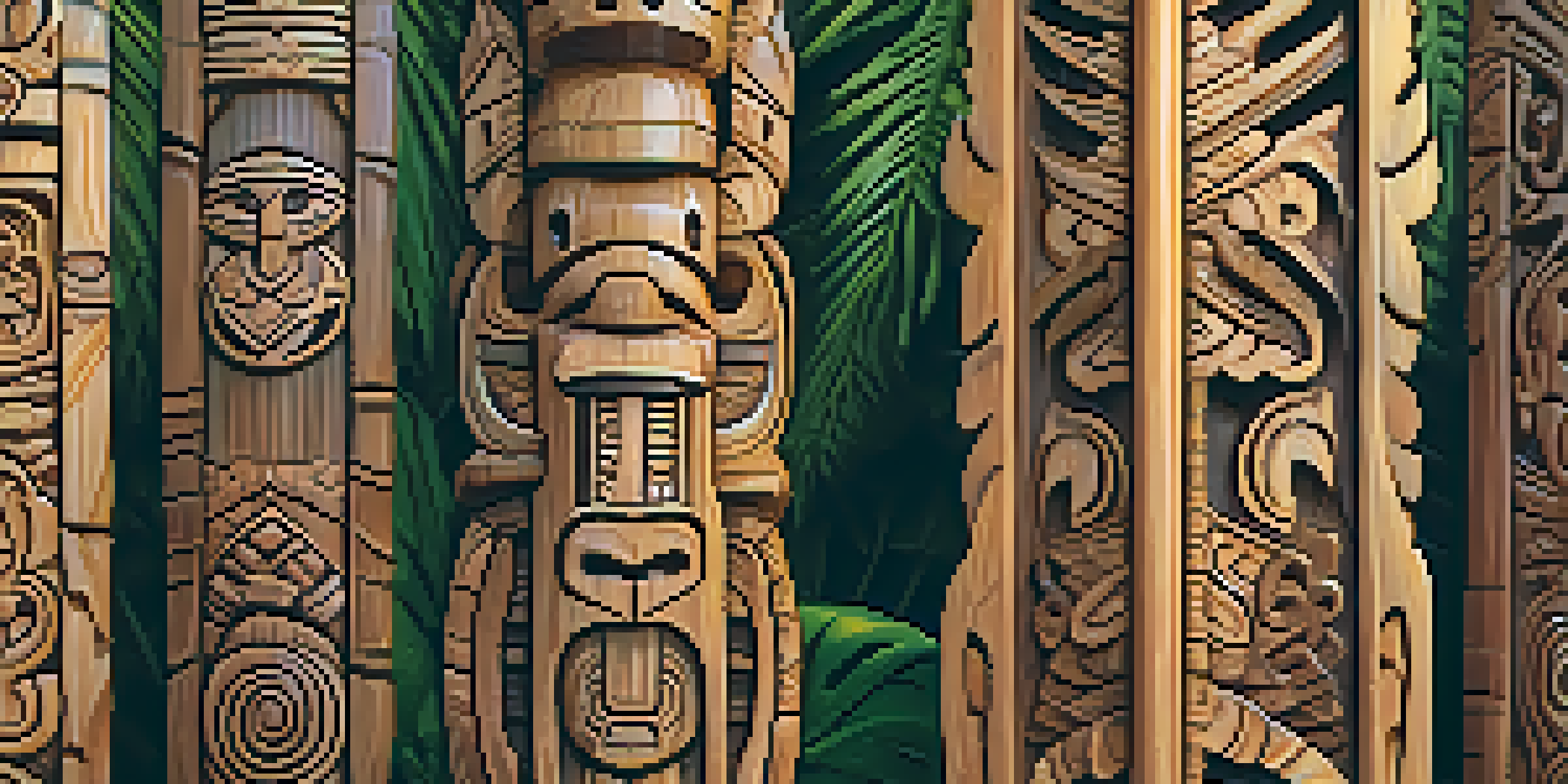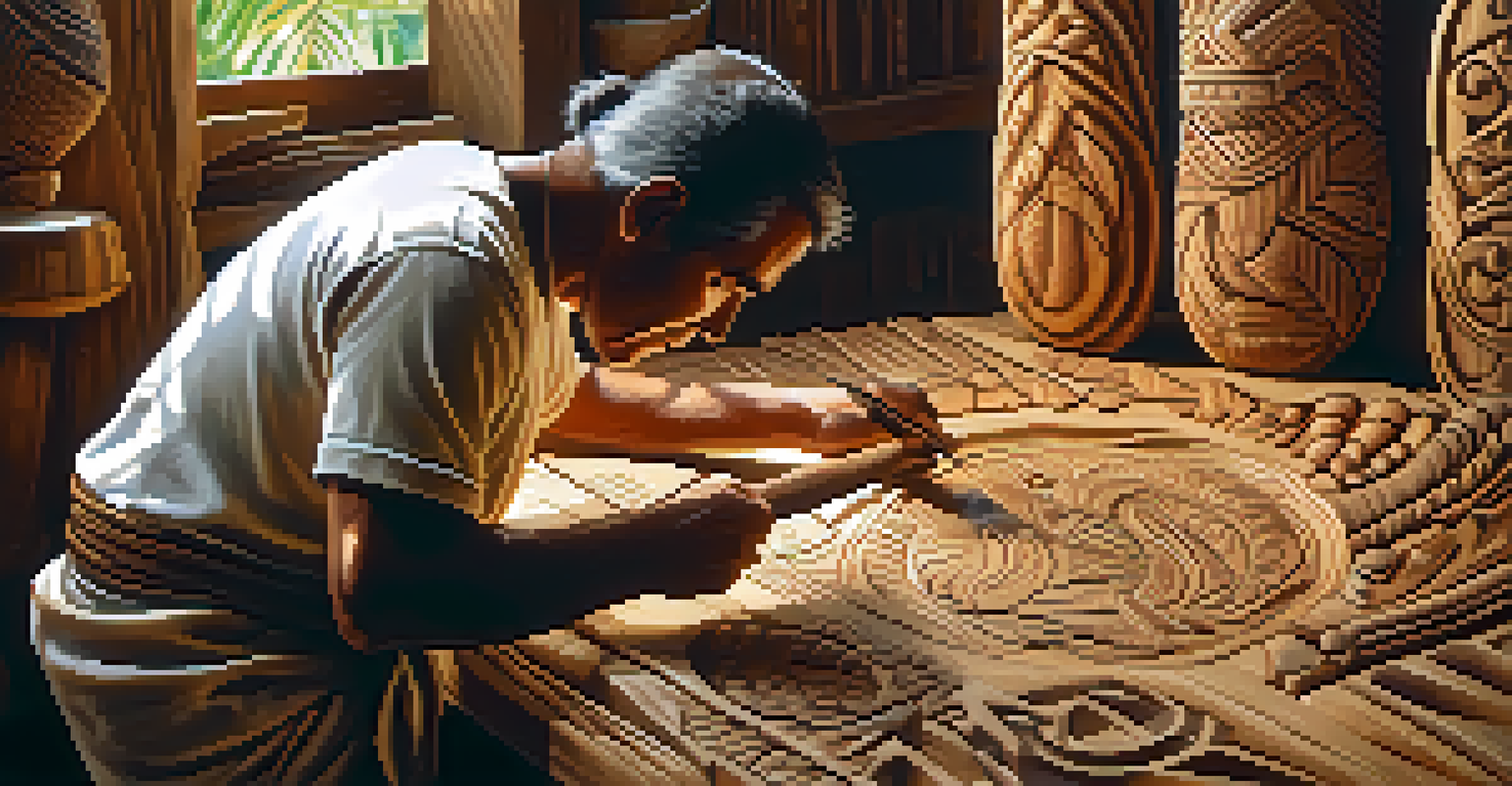Understanding the Symbolism in Polynesian Carving Practices

The Cultural Roots of Polynesian Carving
Polynesian carving is deeply intertwined with the culture and history of the Pacific Islands. Each piece tells a story, representing ancestral connections, mythology, and social status. This art form has been passed down through generations, preserving the unique identity of various Polynesian communities.
Art is the most beautiful of all lies; it is the lie that tells the truth.
Traditionally, these carvings were made from materials like wood, bone, and stone, often depicting figures of gods, ancestors, and significant natural elements. The choice of material is not just aesthetic but also holds spiritual significance, as each medium carries its own meaning and connection to the earth.
Through these carvings, artists express their cultural narratives and beliefs, creating a visual language that resonates with their community. This rich tapestry of symbolism helps to foster a deeper appreciation for the cultural heritage that shapes Polynesian identity.
Common Symbols in Polynesian Carving
Polynesian carvings often incorporate common symbols that reflect core values and beliefs. For instance, the turtle is a prevalent motif representing longevity and endurance, while the shark symbolizes protection and strength. Each symbol is carefully chosen to convey specific messages and cultural significance.

These symbols are not just decorative; they often represent the interconnectedness of life and nature in Polynesian beliefs. The ocean, for instance, is a recurring theme that illustrates the relationship between people and their environment. Carvings depicting waves or fish can symbolize abundance and the sustenance that the sea provides.
Cultural Significance of Carving
Polynesian carvings reflect ancestral connections, mythology, and social status, preserving the unique identity of various communities.
By understanding these symbols, we can gain insight into the worldview of Polynesian cultures. Each carving becomes a window into the spiritual and practical aspects of life, reflecting the values and lessons that have been revered for centuries.
The Role of Carving in Community Identity
Carving is more than an art form in Polynesian societies; it serves as a crucial component of community identity. Carved totems and structures often represent collective histories, celebrating significant events and leaders within the community. This practice fosters a sense of belonging and pride among the people.
Every piece of art is a reflection of the culture that creates it.
In many cases, carving is a communal activity, where members work together to create pieces that reflect their shared values and experiences. This collaborative process strengthens social bonds and ensures that cultural traditions are upheld and passed on to future generations.
Through these carvings, communities can tell their stories, preserving their legacies and instilling pride in their heritage. The act of carving becomes a celebration of identity, allowing people to connect with their past and assert their presence in the present.
The Spiritual Significance of Carvings
Polynesian carvings often carry profound spiritual significance, serving as conduits between the physical and spiritual worlds. Many carvings are created with specific rituals and prayers, invoking the spirits of ancestors or deities for guidance and protection. This spiritual practice elevates the act of carving to a sacred art form.
The presence of ancestral figures in carvings symbolizes the ongoing connection between the living and the dead. These figures remind the community of their lineage, honoring those who came before them. Such representations can also serve as a source of strength and inspiration in times of need.
Community Identity through Art
Carving serves as a vital expression of community identity, celebrating collective histories and fostering social bonds.
In this way, carving becomes a means of communication with the spiritual realm, reinforcing the belief that ancestors continue to watch over and influence the lives of their descendants. This deep-rooted spirituality enriches the meaning behind each carving, transforming it into a powerful symbol of faith.
Techniques and Styles in Polynesian Carving
Polynesian carving techniques vary across the islands, influenced by local resources and cultural preferences. Each region has developed its own distinctive styles, employing tools made from stone, shell, or metal to create intricate designs. This diversity showcases the adaptability and creativity of Polynesian artisans.
One common technique involves the use of relief carving, where designs are carved into the surface of the wood, giving a three-dimensional effect. This method allows for detailed storytelling through visual elements, adding depth and dimension to the carvings. Artists often integrate patterns that hold specific meanings, further enriching the artwork.
The choice of style and technique is often a reflection of the carver's personal touch, making each piece unique. This blend of traditional methods with individual creativity ensures that Polynesian carving remains a vibrant and evolving art form, celebrating both heritage and innovation.
Preservation of Polynesian Carving Traditions
As globalization expands, the preservation of Polynesian carving traditions faces challenges. Many artisans are working to keep these ancient practices alive, often blending traditional techniques with contemporary themes. This fusion allows for the continuation of cultural storytelling while appealing to modern audiences.
Efforts to educate younger generations about the importance of carving are crucial for the survival of this art form. Workshops, cultural festivals, and community events play a pivotal role in fostering interest and appreciation among youth, ensuring that the skills and stories are not lost over time.
Spiritual Connections and Rituals
Many carvings are imbued with spiritual significance, acting as conduits between the physical and spiritual worlds while honoring ancestors.
Moreover, the global interest in indigenous art has provided opportunities for Polynesian carvers to share their work on an international stage. By promoting their art, these artisans not only preserve their heritage but also educate others about the rich symbolism and cultural significance behind each carving.
The Future of Polynesian Carving Practices
Looking ahead, Polynesian carving practices are poised to evolve while retaining their cultural essence. As artists continue to find inspiration in both tradition and modernity, new forms of expression are emerging. This evolution reflects the dynamic nature of culture and the importance of adapting to changing times.
The rise of digital media and technology presents exciting opportunities for showcasing Polynesian carvings to a global audience. Artists are now using platforms like social media to share their work, connect with other artisans, and educate a wider audience about the significance of their craft.

Ultimately, the future of Polynesian carving lies in the balance between preservation and innovation. By honoring their roots while embracing new possibilities, Polynesian artisans can ensure their cultural legacy endures for generations to come.